Effects of Machining Induced Residual Shear and Normal Stresses on Fatigue Life and Stress Intensity Factor of Inconel 718
Abstract
:1. Introduction
2. Theoretical Analysis
2.1. Residual Shear and Normal and Stresses Calculation
2.2. Modeling for Stress Intensity Factor
3. Materials and Methods
3.1. Workpiece Material and Specimen Preparation
3.2. Residual Stress Measurements
3.3. Fatigue Tests
4. Results and Discussion
4.1. Residual Shear and Normal Stress Analysis
4.2. Fatigue Life Analysis
4.3. Evaluation of SIF
5. Conclusions
- •
- The residual normal stresses σxx and σyy were tensile, while the residual shear stresses τxy were negative with the value changes in a range of −265~−211.5 MPa which demonstrated that the residual shear stress was not negligible.
- •
- No clear and orderly tendency was found to conclude that the residual normal and shear stresses influenced the fatigue life. It was demonstrated that the residual stress in only one direction was not a suitable indicator for evaluating fatigue life. It is suggested that the fatigue life of a specimen was not directly dependent upon the surface shear and normal stresses.
- •
- A linear relationship between the equivalent stress and the fatigue life was observed. The fatigue life increased by 39.4% as the equivalent stress decreased by 5.2% in this research. It was indicated that the equivalent stress which considered residual shear and normal stress simultaneously was the dominate factor affecting fatigue life.
- •
- •
- The effect of residual shear stress on the threshold stress intensity factor was significant and ignoring it could cause a considerable deviation from the experimental results.
Author Contributions
Funding
Conflicts of Interest
References
- Ulutan, D.; Ozel, T. Machining induced surface integrity in titanium and nickel alloys: A review. Int. J. Mach. Tools. Manuf. 2011, 51, 250–280. [Google Scholar] [CrossRef]
- Galatolo, R.; Fanteria, D. Influence of turning parameters on the high-temperature fatigue performance of Inconel 718 superalloy. Fatigue Fract. Eng. Mater. Struct. 2017, 40, 2019–2031. [Google Scholar] [CrossRef]
- Li, K.M.; Liu, D.; Wang, Y.F.; Cai, Y.; Hu, J. Investigation on residual stress loss during laser peen texturing of 316L stainless steel. Appl. Sci. 2013, 56, 1029–1037. [Google Scholar] [CrossRef]
- Hua, Y.; Liu, Z.Q.; Wang, B.; Hou, X. Surface modification through combination of finish turning with low plasticity burnishing and its effect on fatigue performance for Inconel 718. Surf. Coat. Technol. 2019, 375, 508–517. [Google Scholar] [CrossRef]
- Thakur, A.; Gangopadhyay, S. State-of-the-art in surface integrity in machining of nickel-based super alloys. Int. J. Mach. Tools. Manuf. 2016, 100, 25–54. [Google Scholar] [CrossRef]
- Yue, C.; Gao, H.; Liu, X.; Liang, S. Part functionality alterations induced by changes of surface integrity in metal milling process: A review. Appl. Sci. 2018, 8, 2550. [Google Scholar] [CrossRef]
- Foss, B.J.; Gray, S.; Hardy, M.C.; Stekovic, S.; McPhail, D.S.; Shollock, B.A. Analysis of shot-peening and residual stress relaxation in the nickel-based superalloy RR1000. Acta. Mater. 2013, 61, 2548–2559. [Google Scholar] [CrossRef]
- Srivastava, M.; Hloch, S.; Krejci, L.; Chattopadhyaya, S.; Dixit, A.R.; Foldyna, J. Residual stress and surface properties of stainless steel welded joints induced by ultrasonic pulsed water jet peening. Measurement 2018, 127, 453–462. [Google Scholar] [CrossRef]
- Jafarian, F.; Amirabadi, H.; Sadri, J. Experimental measurement and optimization of tensile residual stress in turning process of Inconel718 superalloy. Measurement 2015, 63, 1–10. [Google Scholar] [CrossRef]
- Luo, K.Y.; Jing, X.; Sheng, J.; Sun, G.F.; Yan, Z.; Lu, J.Z. Characterization and analyses on micro-hardness, residual stress and microstructure in laser cladding coating of 316L stainless steel subjected to massive LSP treatment. J. Alloys Compd. 2016, 673, 158–169. [Google Scholar] [CrossRef] [Green Version]
- Doremus, L.; Cormier, J.; Villechaise, P.; Henaff, G.; Nadot, Y.; Pierret, S. Influence of residual stresses on the fatigue crack growth from surface anomalies in a nickel-based superalloy. Mater. Sci. Eng. 2015, 644, 234–246. [Google Scholar] [CrossRef]
- Chen, Z.; Moverare, J.J.; Peng, R.L.; Johansson, S.; Gustafsson, D. On the conjoint influence of broaching and heat treatment on bending fatigue behavior of Inconel 718. Mater. Sci. Eng. A 2016, 671, 158–169. [Google Scholar] [CrossRef]
- Kattoura, M.; Mannava, S.R.; Qian, D.; Vasudevan, V.K. Effect of ultrasonic nanocrystal surface modification on elevated temperature residual stress, microstructure, and fatigue behavior of ATI 718Plus alloy. Int. J. Fatigue 2018, 110, 186–196. [Google Scholar] [CrossRef]
- Fleury, R.M.N.; Nowell, D. Evaluating the influence of residual stresses and surface damage on fatigue life of Nickel superalloys. Int. J. Fatigue 2017, 105, 27–33. [Google Scholar] [CrossRef]
- Martin-Meizoso, A.; Martinez-Esnaola, J.M.; Arrazola, P.J.; Linaza, A. Surface machining condition and fatigue life on Inconel 718. Procedia Struct. Integr. 2018, 13, 1609–1614. [Google Scholar] [CrossRef]
- Moussaoui, K.; Mousseigne, M.; Senatore, J.; Chieragatti, R.; Lamesle, P. Influence of milling on the fatigue lifetime of a Ti6Al4V titanium alloy. Metals 2015, 5, 1148–1162. [Google Scholar] [CrossRef]
- Moussaoui, K.; Mousseigne, M.; Senatore, J.; Chieragatti, R. The effect of roughness and residual stresses on fatigue life time of an alloy of titanium. Int. J. Adv. Manuf. Technol. 2015, 78, 557–563. [Google Scholar] [CrossRef]
- Delbergue, D.; Texier, D.; Lévesque, M.; Bocher, P. Comparison of two X-ray residual stress measurement methods: Sin2 ψ and cos α, through the determination of a martensitic steel X-ray elastic constant. Mater. Res. Proc. 2016, 2, 55–60. [Google Scholar]
- Taira, S.; Tanaka, K.; Yamasaki, T. A method of X-ray microbeam measurement of local stress and its application to fatigue crack growth problems. J. Soc. Mater. Sci. Jpn. 1978, 27, 251–256. [Google Scholar] [CrossRef]
- Sasaki, T.; Takahashi, S.; Sasaki, K.; Kobayashi, Y. A study on improvements in multiaxial stress analysis with area detector type diffraction method. Trans. Jpn. Soc. Mech. Eng. Part A 2009, 75, 219–227. [Google Scholar] [CrossRef]
- Li, W.; Zhao, H.; Nehila, A.; Zhang, Z.; Sakai, T. Very high cycle fatigue of TC4 titanium alloy under variable stress ratio: Failure mechanism and life prediction. Int. J. Fatigue 2017, 104, 342–354. [Google Scholar] [CrossRef]
- Hua, Y.; Liu, Z.Q. Experimental investigation of principal residual stress and fatigue performance for turned nickel-based superalloy inconel 718. Materials 2018, 11, 879. [Google Scholar] [CrossRef]
- Hanabusa, T.; Fujiwara, H. Relation between psi-splitting and microscopic residual shear stresses in x-ray stress measurement on uni-directionally deformed layers. J. Soc. Mater. Sci. Jpn. 1982, 31, 227–233. [Google Scholar] [CrossRef]
- Kamura, N.; Fujita, T.; Sasaki, T. Evaluation of rolling contact fatigue by X-ray diffraction ring. NTN Tech. Rev. 2015, 83, 63–74. [Google Scholar]
- Navas, V.G.; Gonzalo, O.; Bengoetxea, I. Effect of cutting parameters in the surface residual stresses generated by turning in AISI 4340 steel. Int. J. Mach. Tools. Manuf. 2012, 61, 48–57. [Google Scholar] [CrossRef]
- Devillez, A.; Le Coz, G.; Dominiak, S.; Dudzinski, D. Dry machining of Inconel 718, workpiece surface integrity. J. Mater. Process. Technol. 2011, 211, 1590–1598. [Google Scholar] [CrossRef]
- Moussa, N.B.; Sidhom, H.; Braham, C. Numerical and experimental analysis of residual stress and plastic strain distributions in machined stainless steel. Int. J. Mech. Sci. 2012, 64, 82–93. [Google Scholar] [CrossRef]
- Klotz, T.; Delbergue, D.; Bocher, P.; Lévesque, M.; Brochu, M. Surface characteristics and fatigue behavior of shot peened Inconel 718. Int. J. Fatigue 2018, 110, 10–21. [Google Scholar] [CrossRef]
- Mercer, C.; Soboyejo, A.B.O.; Soboyejo, W.O. Micromechanisms of fatigue crack growth in a forged Inconel 718 nickel-based superalloy. Mater. Sci. Eng. A 1999, 270, 308–322. [Google Scholar] [CrossRef]
- Clavel, M.; Pineau, A. Fatigue behavior of two nickel-base alloys I: Experimental results on low cycle fatigue, fatigue crack propagation and substructures. Mater. Sci. Eng. A 1982, 55, 157–171. [Google Scholar] [CrossRef]
- Osinkolu, G.A.; Onofrio, G.; Marchionni, M. Fatigue crack growth in polycrystalline IN 718 superalloy. Mater. Sci. Eng. A 2003, 356, 425–433. [Google Scholar] [CrossRef]
- Yamada, Y.; Newman, J.C., Jr. Crack closure under high load-ratio conditions for Inconel-718 near threshold behavior. Eng. Fract. Mech. 2009, 76, 209–220. [Google Scholar] [CrossRef]
- Newman, J.C., Jr.; Yamada, Y. Compression precracking methods to generate near-threshold fatigue-crack-growth-rate data. Int. J. Fatigue 2010, 32, 879–885. [Google Scholar] [CrossRef]
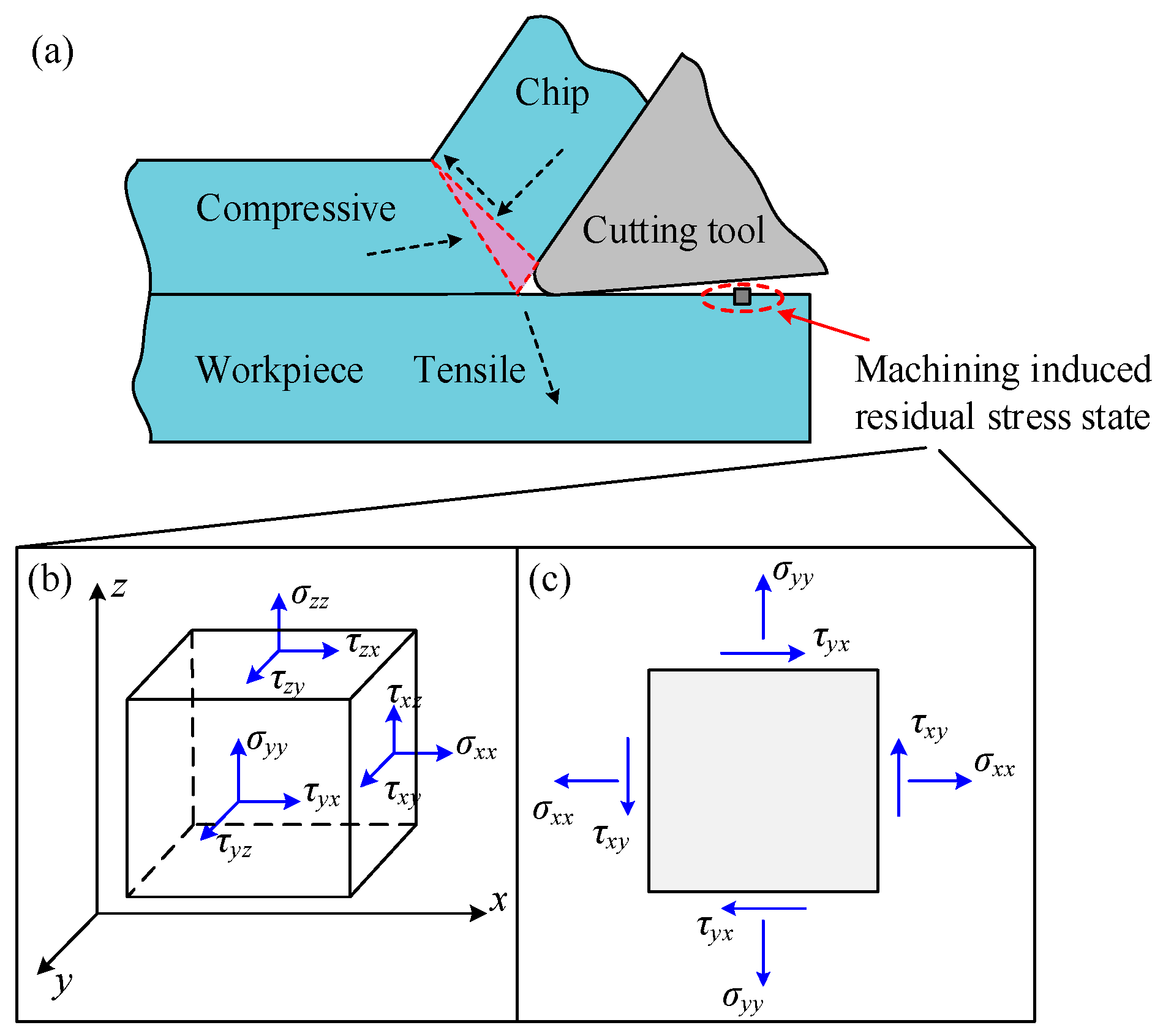
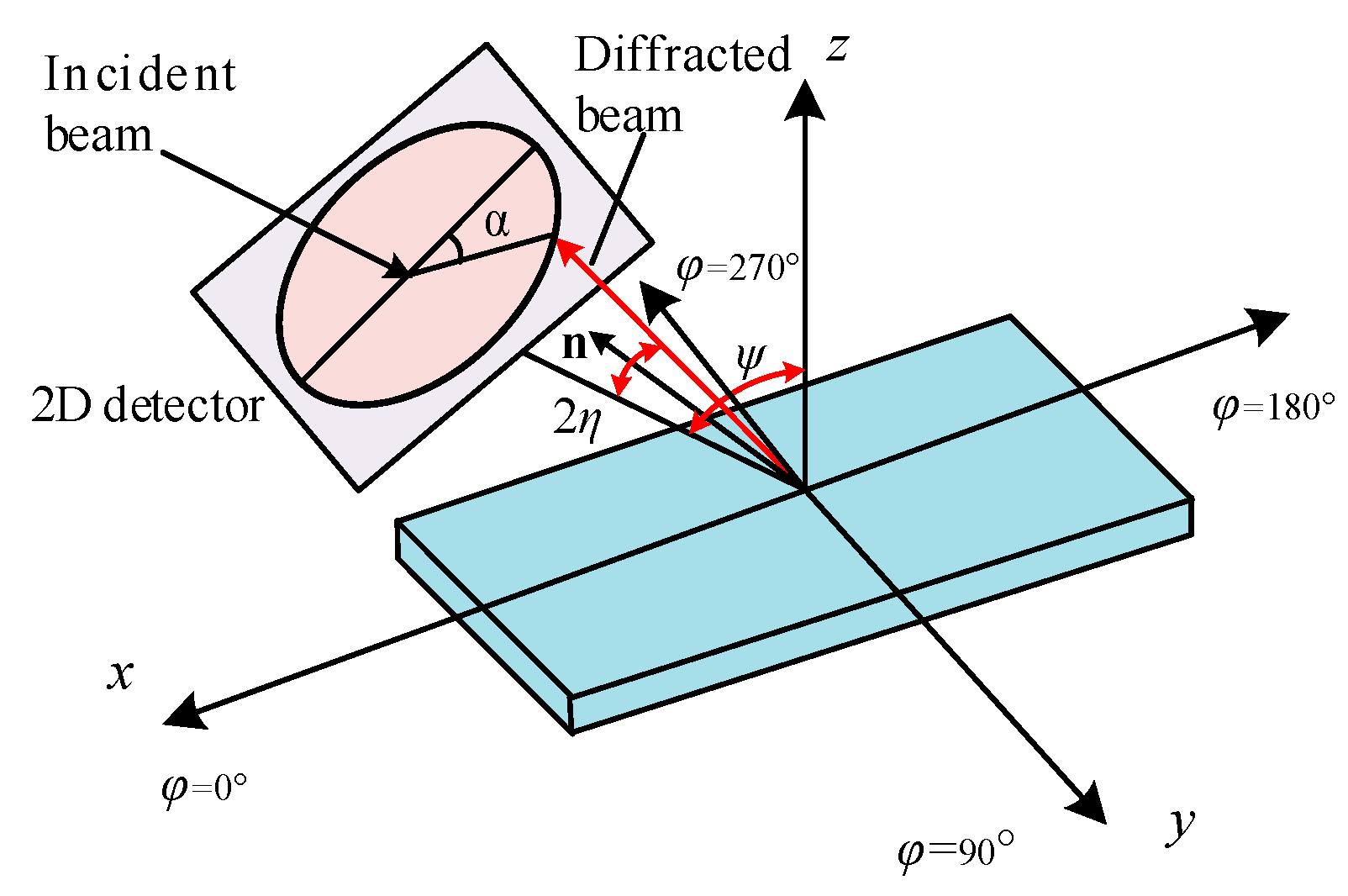


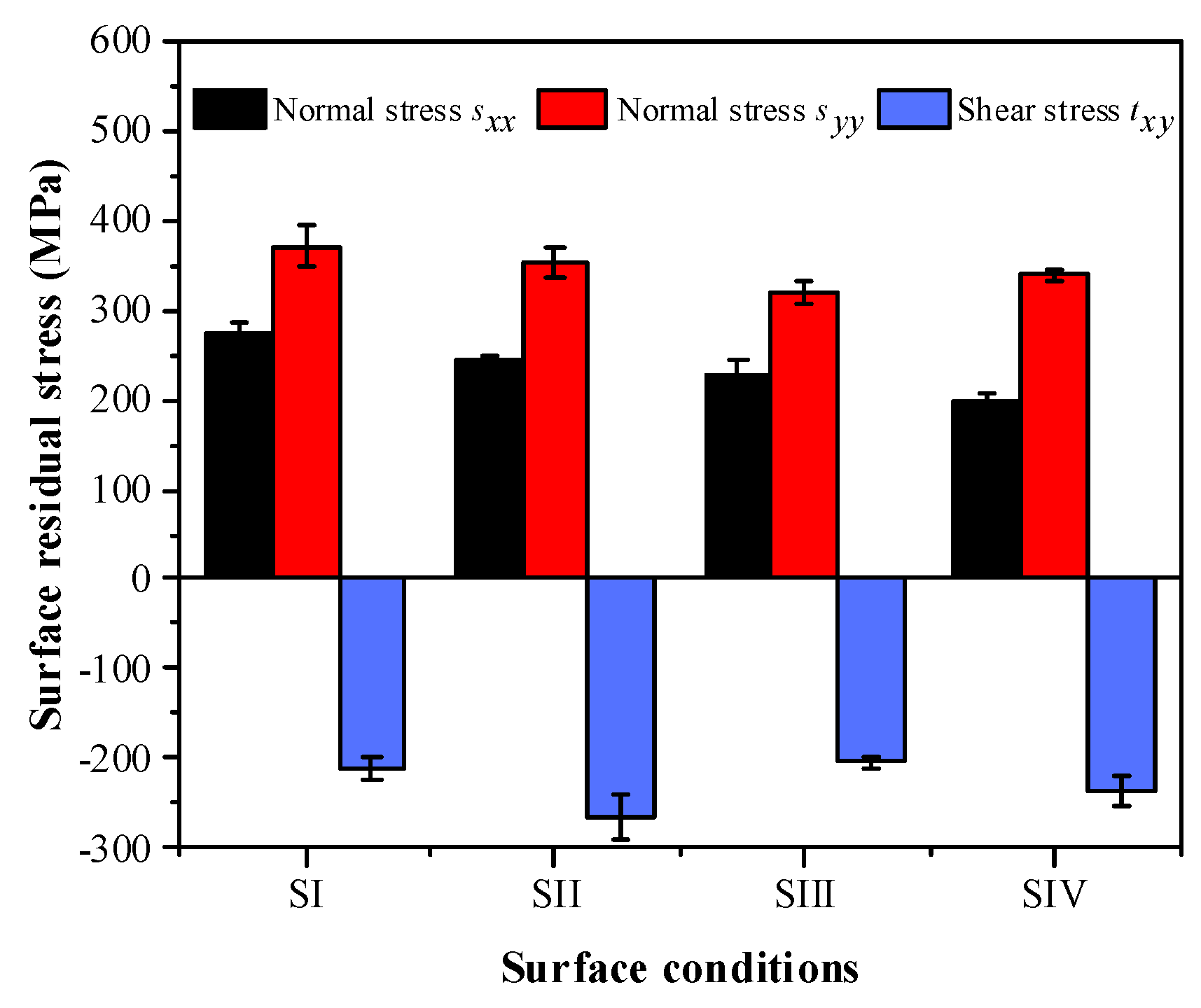
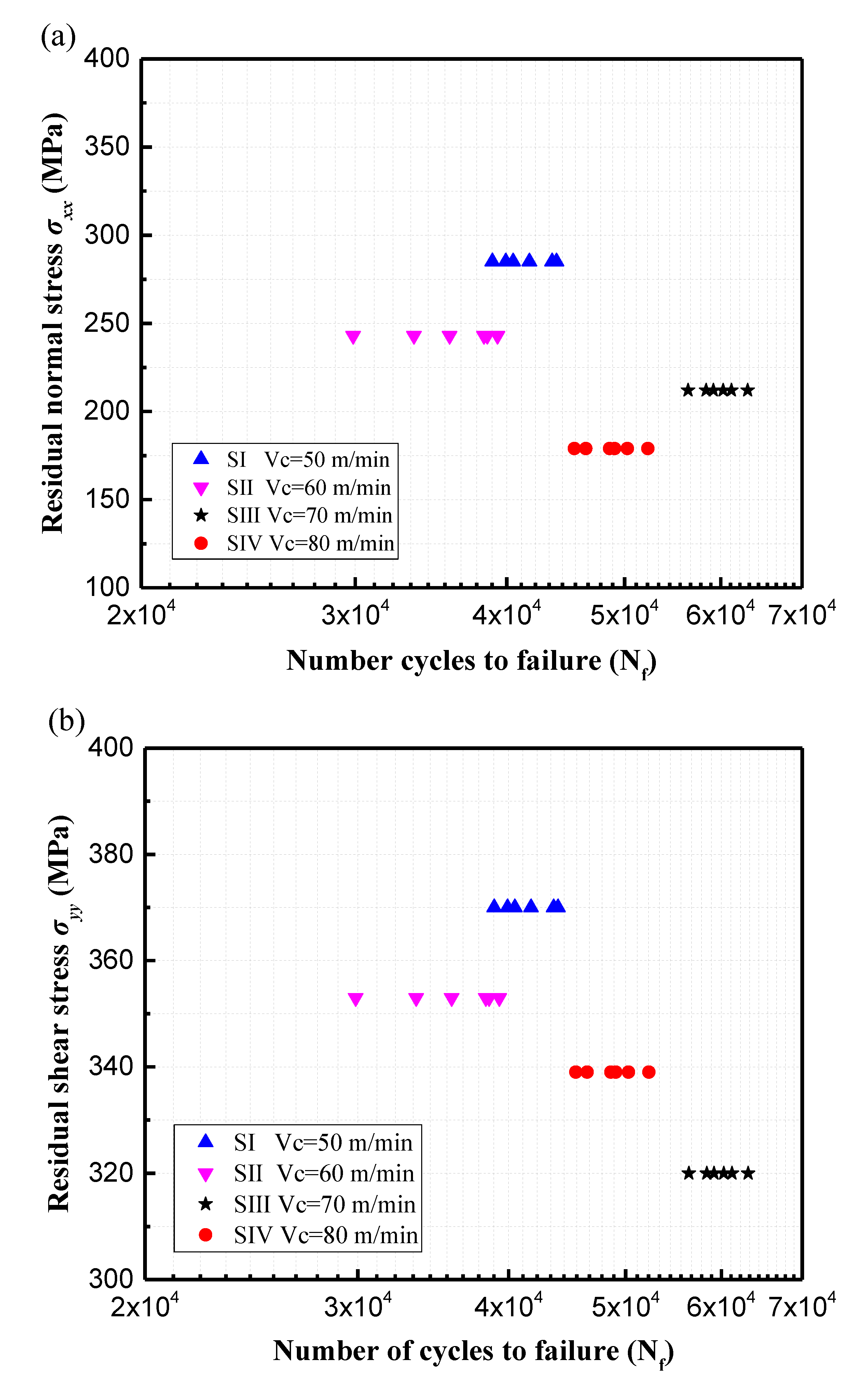
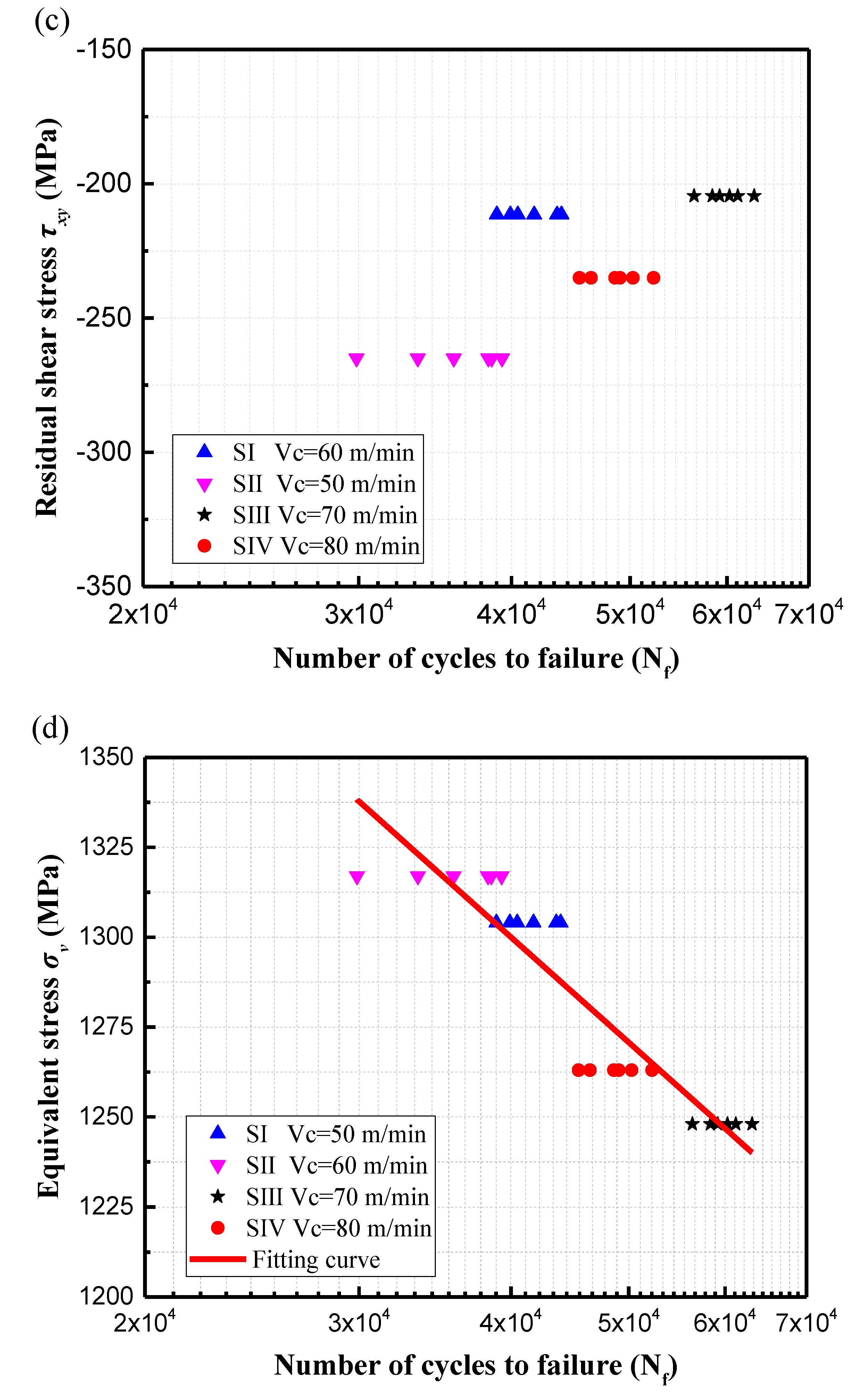
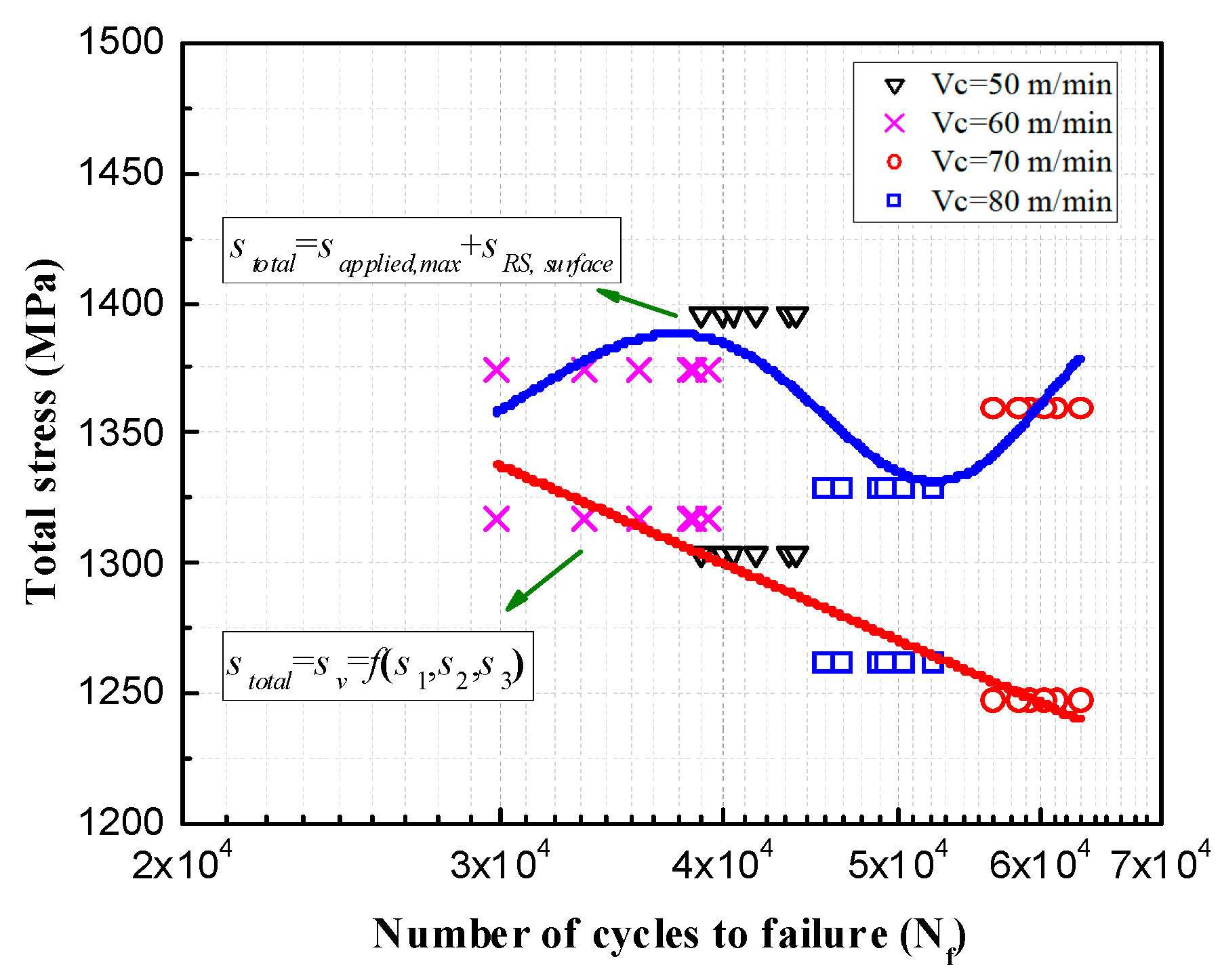

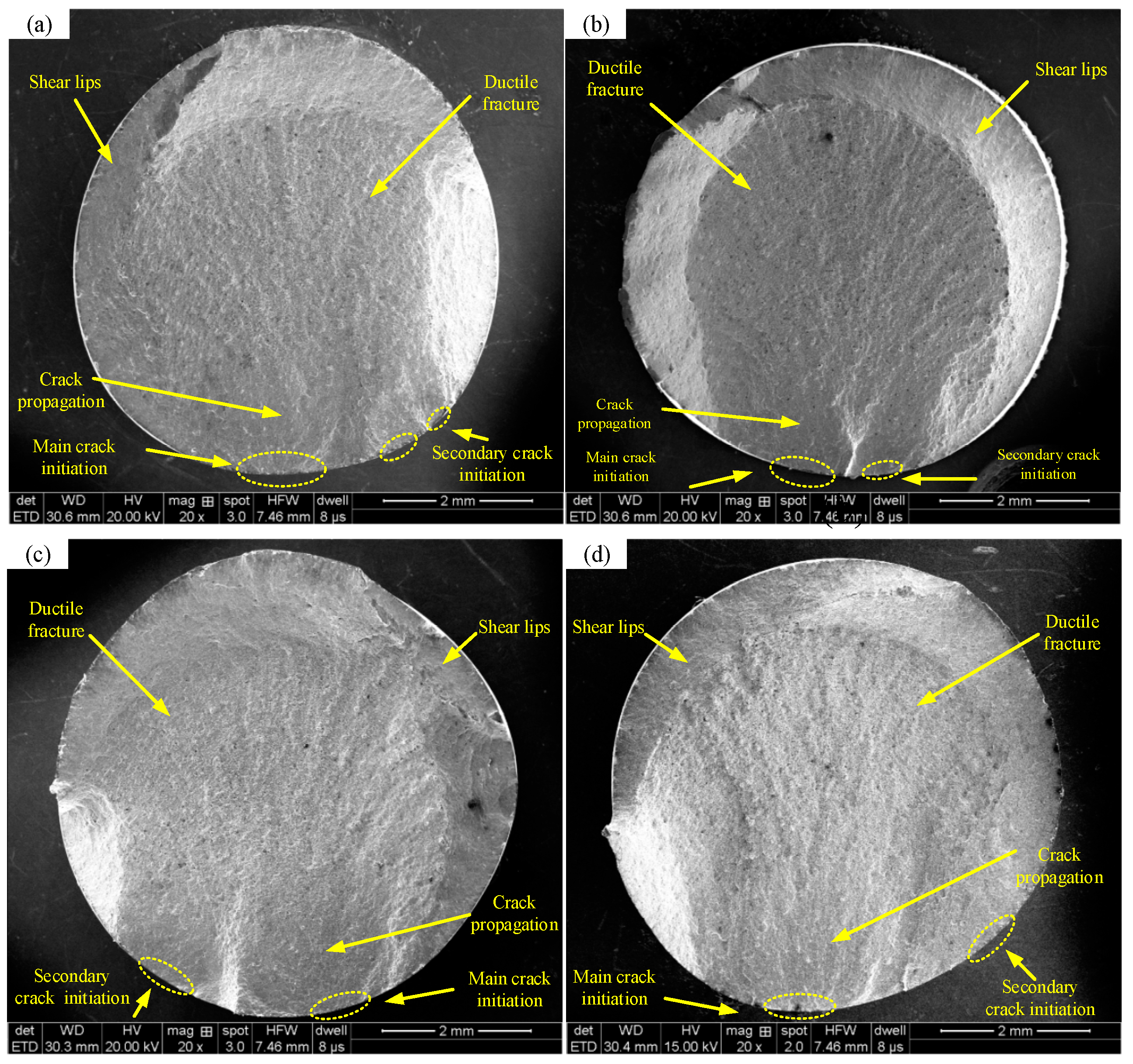
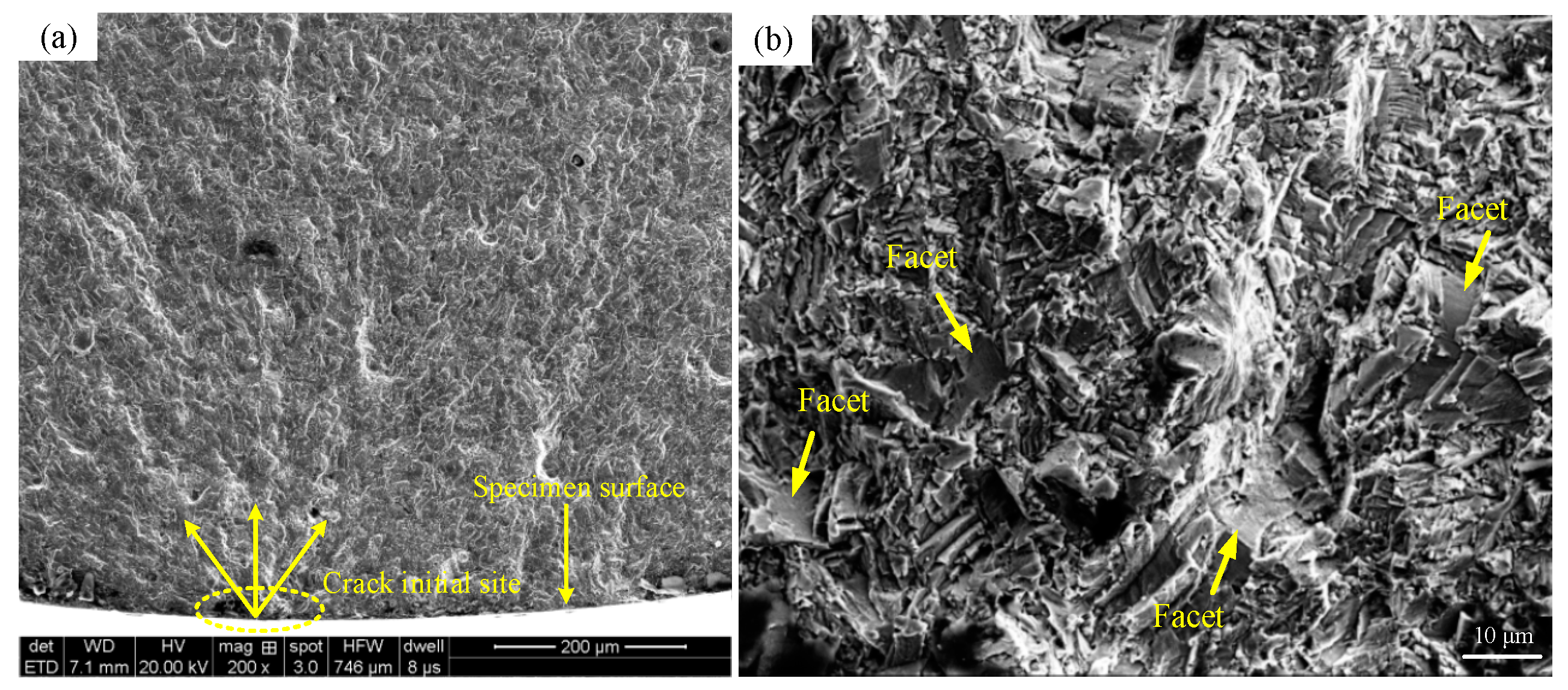
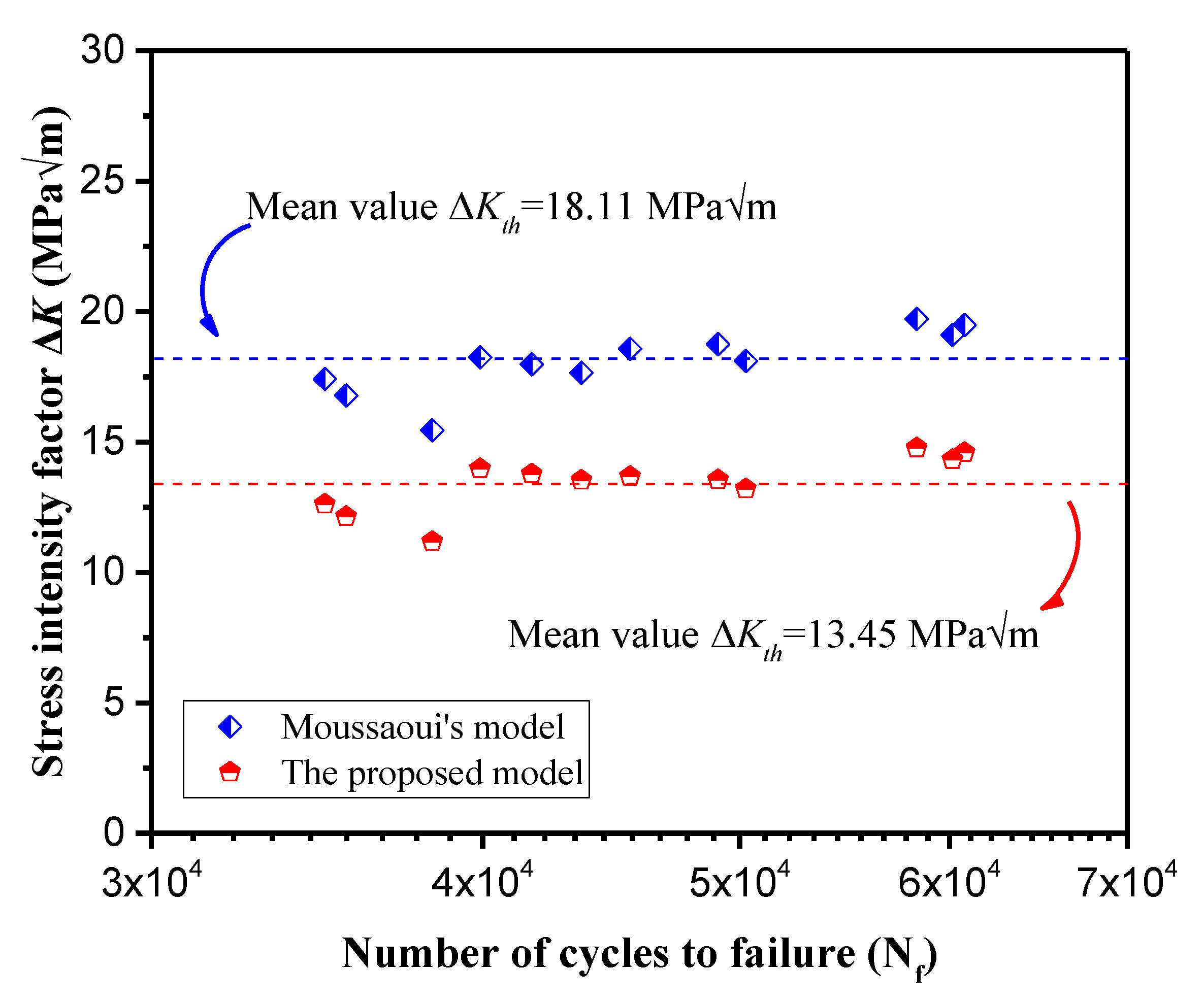

| Cr | Nb | Al | Ni | Mn | Mo | Cu | Ti | Co | Si |
| 18.05 | 5.43 | 0.50 | 53.51 | 0.062 | 2.98 | 0.035 | 1.02 | 0.31 | 0.074 |
| Sn | Ta | N | C | P | B | Ca | Mg | S | Fe |
| 0.00091 | 0.0085 | 0.0079 | 0.025 | 0.010 | 0.0042 | 0.0032 | 0.0014 | 0.00078 | Bal |
| Elastic Modulus E (GPa) | Ultimate Tensile Strength σb (MPa) | Yield Strength σ0.2 (MPa) | Elongation (%) | Hardness (HBW) |
|---|---|---|---|---|
| 205 | 1502 | 1360.5 | 19.3 | 439 |
| Condition | Cutting Speed Vc (m/min) | Feed Rate f (mm/rev) | Depth of Cut ap (mm) | Tool Nose Radius r (mm) |
|---|---|---|---|---|
| SI | 50 | 0.075 | 0.2 | 0.8 |
| SII | 60 | |||
| SIII | 70 | |||
| SIV | 80 |
| Specimen | Tube target | Crystallographic plane | Diffraction angle (2θ) |
| Inconel 718 | Cr | {311} | 150.89° |
| Tube voltage | Tube current | X-ray slit | Exposure time |
| 30 kV | 1 mA | 2 mm | 90 s |
| Machining Conditions | No. | Facet Area (mm2) | Moussaoui’s Model [16,17] | The Proposed Model | ||||
|---|---|---|---|---|---|---|---|---|
| σlocal,max | σlocal,min | Δσeff | σv,max | σv,min | Δσ′eff | |||
| Vc = 50 m/min | 1 | 0.05854 | 1406 | 388.1 | 1017.9 | 1304 | 523.6 | 780.4 |
| 3 | 0.05526 | 1406 | 388.1 | 1017.9 | 1304 | 523.6 | 780.4 | |
| 4 | 0.05148 | 1406 | 388.1 | 1017.9 | 1304 | 523.6 | 780.4 | |
| Vc = 60 m/min | 7 | 0.03014 | 1374 | 356.1 | 1017.9 | 1317 | 579.9 | 737.1 |
| 9 | 0.04876 | 1374 | 356.1 | 1017.9 | 1317 | 579.9 | 737.1 | |
| 12 | 0.04198 | 1374 | 356.1 | 1017.9 | 1317 | 579.9 | 737.1 | |
| Vc = 70 m/min | 13 | 0.07619 | 1374 | 342.1 | 1017.9 | 1248 | 485 | 763 |
| 14 | 0.07061 | 1360 | 342.1 | 1017.9 | 1248 | 485 | 763 | |
| 17 | 0.08001 | 1360 | 342.1 | 1017.9 | 1248 | 485 | 763 | |
| Vc = 80 m/min | 19 | 0.06538 | 1330 | 312.1 | 1017.9 | 1264 | 521 | 743 |
| 21 | 0.06297 | 1330 | 312.1 | 1017.9 | 1264 | 521 | 743 | |
| 24 | 0.05689 | 1330 | 312.1 | 1017.9 | 1264 | 521 | 743 | |
© 2019 by the authors. Licensee MDPI, Basel, Switzerland. This article is an open access article distributed under the terms and conditions of the Creative Commons Attribution (CC BY) license (http://creativecommons.org/licenses/by/4.0/).
Share and Cite
Hua, Y.; Liu, Z. Effects of Machining Induced Residual Shear and Normal Stresses on Fatigue Life and Stress Intensity Factor of Inconel 718. Appl. Sci. 2019, 9, 4750. https://doi.org/10.3390/app9224750
Hua Y, Liu Z. Effects of Machining Induced Residual Shear and Normal Stresses on Fatigue Life and Stress Intensity Factor of Inconel 718. Applied Sciences. 2019; 9(22):4750. https://doi.org/10.3390/app9224750
Chicago/Turabian StyleHua, Yang, and Zhanqiang Liu. 2019. "Effects of Machining Induced Residual Shear and Normal Stresses on Fatigue Life and Stress Intensity Factor of Inconel 718" Applied Sciences 9, no. 22: 4750. https://doi.org/10.3390/app9224750





